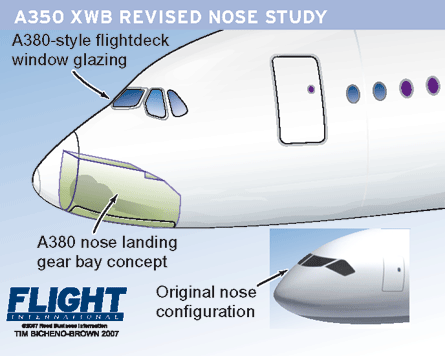Airbus is evaluating a more conventional nose shape for the A350 XWB derived from that of the A380 as it continues to refine the twinjet's design. The manufacturer has also tweaked the fuselage shape to create a slightly wider cabin, and revealed plans for a variable camber wing to improve cruise efficiency.
Airbus says the A350's new nose shape is "one of several design studies" it is working on, but has not yet frozen the design. It has adopted the A380-derived nosewheel-bay configuration, which puts the landing gear much further forward than previous Airbus widebodies, in the space directly under the cockpit.
 |
|---|
This configuration required Airbus to relocate the flightcrew rest area in the fuselage crown rather than below the cockpit as proposed on the previous A350 design.
A computer-aided design drawing graphic released by Airbus of one of the A350 nose configurations under study reveals that it now has a more conventionally shaped nose and flightdeck window layout compared with the one shown in all A350 XWB images released to date. Rather than the angular, four-window design, the study has a six-window configuration bearing a family resemblance to the A380's cockpit glazing.
The manufacturer is refining the XWB's aerodynamics using computational fluid dynamics (CFD) and windtunnel testing, says A350 chief engineer Gordon McConnell: "With the CFD design tools and the computing power now available we can iterate the design much faster, and we have been able to reduce the windtunnel time by 40% compared to the A380."
Despite the greater reliance on CFD, Airbus is still carrying out traditional windtunnel testing with low-speed trials being undertaken at its Bremen and Filton plants and at France's ONERA institute. Airbus is "very happy with the results", says Evrard, who says the latest tweaks to the double-bubble fuselage shape have seen a more rounded upper lobe be adopted.
These changes have increased the internal cabin diameter at shoulder and armrest height by 2.5cm (1in) and 5cm respectively, giving the A350 a maximum internal diameter of 559cm, further increasing the advantage it has over the rival 787, which Airbus credits with a maximum internal width of 546cm.
Airbus chief operating officer customers John Leahy says the increased cabin size has prompted some airlines to ask Airbus to look at a high-density 10-abreast seating configuration using seats similar in width to those in a nine-abreast configured A300 or A330.
Source: Flight International
















